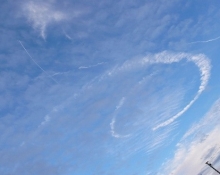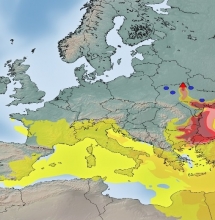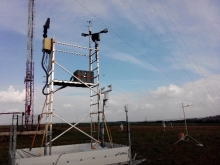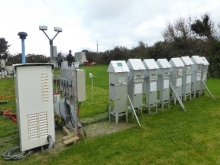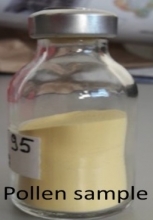Working Group Lead: Olivier Masson (IRSN, France)
Contact: olivier.masson@irsn.fr
Working Group Overview
Despite several decades of research in the atmospheric domain, there are still some remaining gaps to fill to improve our prediction capability about the fate of radionuclides released into the atmosphere or from those that are naturally occurring. Our top priority objectives are: (i) to improve inhalation dose assessment; (ii) to update our knowledge about transfer processes and interactions with other compartments of the biosphere; (iii) to characterize radionuclide deposition which will correspond to the entry parameter of the contamination of marine and terrestrial compartments. All the ensuing actions can be addressed in response to emergency situations and routine (i.e. normal) conditions. These actions within this framework are aimed at: (i) the representativness of our sampling and measurements to strenghthen model validation and (ii) understanding of the key parameters involved in the temporal changes of both physical and chemical airborne radionuclide features.
The work to be done in this WG is highly relevant to the SRA Challenge 1 (To predict human and wildlife exposure in a robust way by quantifying key processes that influence radionuclide transfers and exposure). In particular, it is relevant to Research Line 1(RL1, Identify and mathematically represent key processes that make significant contributions to the environmental transfers of radionuclides and resultant exposures of humans and wildlife) and to RL2 (Acquire the data necessary for parameterisation of the key processes controlling the transfer of radionuclides) and RL4 (Represent radionuclide transfer and exposure at a landscape or global environmental level with an indication of the associated uncertainty). It also relates to Challenge 3 (To improve human and environmental protection by integrating radioecology’) and in particular to its RL1 (Integrate uncertainty and variability from transfer modelling, exposure assessment, and effects characterisation into risk characterisation).
The research is relevant to NERIS, particularly to take advantage of analytical parameters derived from field experiments and related to short-term interactions of radionuclide-labeled aerosol with fog droplets and snowflakes. Suitable deposition velocities or deposition flux in such conditions are not yet implemented in operational models. This research is also relevant and consitent with the WP2 priorities indentified by the European project CONFIDENCE which has ranked at the highest level the question of the iodine speciation in the methods aimed at reducing typical uncertainty assessment.
Working Group Activities
Noticeable investigations have been made after the Fukushima accident or during recent continent-wide dispersion events related to unusual or unexpected airborne radionuclides detections (106Ru, 131I, 75Se, 137Cs) (Masson et al., 2018, 2019; Hopp et al., 2020). They revealed for instance the lack of gaseous iodine speciation but were also an opportunity to investigate nuclear forensics as a powerful multi-discipline to address radionuclide origin and sources. Routine discharges are also used to study key topics. For instance, 129I is useful as a proxy of 131I to study the transfer kinetics between the different iodine species, or for the reconstruction of 131I airborne concentration and deposition.
More in detail, the top priority questions about the mechanisms involved are targeted to: i) unusual and difficult to model aerosol deposition conditions such as fog, cloud, and snowfall; (ii) long term persistence of airborne radionuclides as a resut of emission or re-emission of radionuclide by wildfires, soil particle resupension, volcanic eruptions, and biogenic aerosol production; (iii) change in the size distribution of airborne radionuclides. This size distribution is almost unknown for the fine aerosol fraction lower than 0.4 µm. This fraction enters deeper in the respiratory tract. As a result it is associated with higher dose coefficients than that considered for a 1 µm aerosol size. Reference size distributions in routine conditions for further comparison with those obtained in emergency situations will also help the identification and characterisation of the radionuclide emission, volatile to non-volatile transfer processes, plume depletion and the corresponding associated deposition. Other pending topics of interest are for instance the current Pu isotopic ratio, and activity ratios between 241Am, Pu, 90Sr, and 137Cs in the atmosphere which sometimes show unexpected values.
As a side event of the ENVIRA and ICRER international conferences, we regularly hold a joint meeting with the Ring of Five (Ro5) network to address our questions about the detection of unusual radionuclides in the atmosphere or at unexpected concentrations.
Working Group Members
Alternative Energies and Atomic Energy Commission (CEA, France); Center for Energy, Environmental and Technological Research (CIEMAT, Spain); Center for Environmental Radioactivity (NMBU-CERAD, Norway); Central Mining Institute (GIG, Poland); Environmental Radioactivity Laboratory of the University of Extremadura (LARUEX, Spain); Federal Office for Radiation Protection (BfS, Germany); Institute for Radiological Protection and Nuclear Safety (IRSN, France); Institute of Nuclear and Particle Physics (NCSR Demokritos, Greece); Leibniz Universität Hannover (Germany); Radiation and Nuclear Safety Authority (DSA, Norway); Technical University of Lisbon (Portugal).
Any member of the ALLIANCE can become a member of a Working Group (email the appropriate Working Group Leader).
Page last updated: Apr/May 2020

